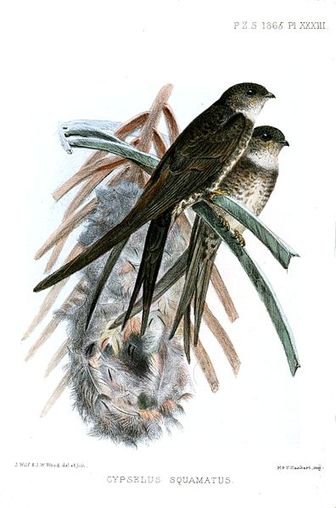Fork-tailed Palm-Swift
This small swift is found locally in marshy habitats, or sometimes open forest, usually near Moriche Palms. It builds a C-shaped nest of feathers, saliva and plant material on the inside of the dead leaf of a Moriche Palm. Three white eggs are laid in the depression of the C, and incubated for 21 days to hatching.

The Fork-tailed Palm-Swift is classified as Least Concern. Does not qualify for a more at risk category. Widespread and abundant taxa are included in this category.
Fork-tailed Palm-Swift (Tachornis squamata) photo Trinidad September, 2005 More
Fork-tailed Palm-Swifts (Tachornis squamata) is a South American species that constructs its nests - made of feathers, some plant matter, and saliva - inside the folded dead leaf of a few species of palms. Although it was known that the palm-swifts require one to three months to build the nests, it was not known how they acquired enough feathers to complete the structure. More
Fork-tailed Palm-Swift Tachornis squamata = Bel More
Fork-tailed Palm-Swift Tachornis squamata = Described by: Cassin (1853) Alternate common name(s): Neotropical Palm Swift, Neotropical Palm-Swift, Fork-tailed Swift Old scientific name(s): Reinarda squamata Photographs Napo Wildlife Center, Ecuador - Jan 10, 2006 More
Fork-tailed Palm-Swift (Tachornis squamata) by Ciro Albano. More
Photo of a fork-tailed palm-swift high in the air, made by Peter Reslon in Suriname in 2002. It is often seen circling over or near areas with palms (like stands of the Moriche palms in wet savannna near Zanderij airport where this photo was taken). In those trees it will also make its nest. More
Family : Apodidae
Genus : Tachornis
Species : squamata
Authority : (Cassin, 1853)

